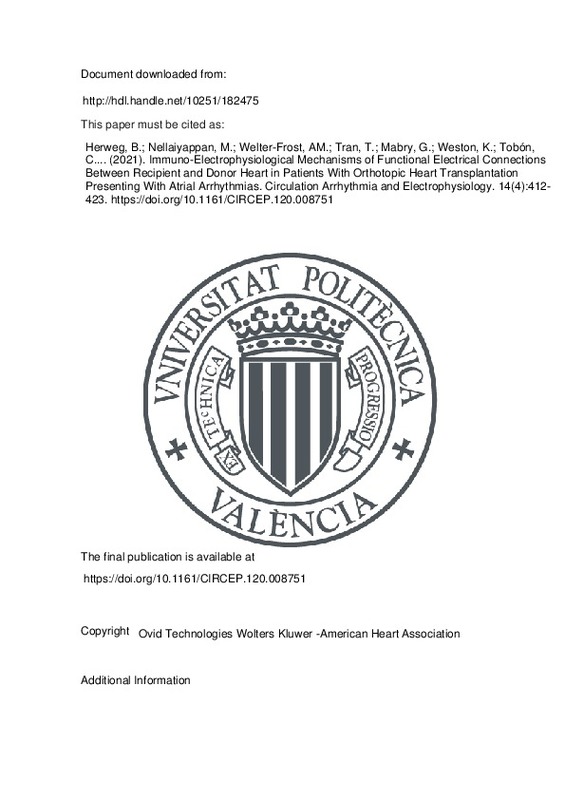JavaScript is disabled for your browser. Some features of this site may not work without it.
Buscar en RiuNet
Listar
Mi cuenta
Estadísticas
Ayuda RiuNet
Admin. UPV
Immuno-Electrophysiological Mechanisms of Functional Electrical Connections Between Recipient and Donor Heart in Patients With Orthotopic Heart Transplantation Presenting With Atrial Arrhythmias
Mostrar el registro sencillo del ítem
Ficheros en el ítem
| dc.contributor.author | Herweg, Bengt
|
es_ES |
| dc.contributor.author | Nellaiyappan, Madhan
|
es_ES |
| dc.contributor.author | Welter-Frost, Allan M.
|
es_ES |
| dc.contributor.author | Tran, Thanh
|
es_ES |
| dc.contributor.author | Mabry, George
|
es_ES |
| dc.contributor.author | Weston, Kathryn
|
es_ES |
| dc.contributor.author | Tobón, Catalina
|
es_ES |
| dc.contributor.author | Saiz Rodríguez, Francisco Javier
|
es_ES |
| dc.contributor.author | Noujaim, Sami
|
es_ES |
| dc.contributor.author | Weston, Mark W.
|
es_ES |
| dc.date.accessioned | 2022-05-10T18:06:18Z | |
| dc.date.available | 2022-05-10T18:06:18Z | |
| dc.date.issued | 2021-04 | es_ES |
| dc.identifier.issn | 1941-3149 | es_ES |
| dc.identifier.uri | http://hdl.handle.net/10251/182475 | |
| dc.description.abstract | [EN] BACKGROUND: The formation of recipient-to donor atrio-atrial connections (AAC) in patients after orthotopic heart transplantation (OHT) is poorly understood. We sought to investigate the mechanisms of atrial tachyarrhythmias after OHT, the role of AACs, and their relationship to the immunologic match. METHODS: In a large series of OHT patients, we performed a retrospective review of 42 patients who underwent catheter ablation for atrial arrhythmias. A realistic 3-dimensional computer model of human atria was used to study AAC conductivity. RESULTS: Patient age was 55 +/- 15 years (71% male). Biatrial anastomosis was present in 24/42 patients (57%). An AAC was found in 9/42 patients (21%, right-sided in 5 patients with biatrial anastomosis, left-sided in 4 patients). The AAC became apparent at the time of the electrophysiology study 10.1 +/- 7.6 years after OHT (range, 0.3-22.2 years). Donor-specific antibodies were present in no patient with AAC but were present in 69% of patients without AAC, P=0.002. In all patients with AAC, a recipient atrial tachycardia propagated via AAC to the donor atrium (4 patients presented with atrial fibrillation). Simulations showed AAC conduction requires an isthmus of >= 2 mm and is cycle length and location dependent. Patients without AAC (n=13) frequently presented with donor atrial arrhythmias, in 77% cavo-tricuspid isthmus flutter was ablated. The procedural success was high, although, 12 patients (29%) required reablation. CONCLUSIONS: AACs are found in 21% of OHT patients with atrial tachyarrhythmias and can manifest very early after OHT. Immune privilege characterized by the absence of donor-specific antibodies may facilitate AAC formation. Propagation across an AAC is width, cycle length, and location dependent. Patients with AAC present with focal atrial tachycardias or atrial fibrillation originating from the recipient atria; patients without most frequently present with cavo-tricuspid isthmus dependent atrial flutter. While multiple arrhythmias frequently require reablation, ablative therapy is highly effective. | es_ES |
| dc.description.sponsorship | This study was supported in part by National Institutes of Health grants R21HL138064, and R01HL129136 to Dr Noujaim. This work was partially supported by the Direccion General de Politica Cientifica de la Generalitat Valenciana (PROMETEU2020/043). | es_ES |
| dc.language | Inglés | es_ES |
| dc.publisher | Ovid Technologies Wolters Kluwer -American Heart Association | es_ES |
| dc.relation | GENERALITAT VALENCIANA//PROMETEO%2F2012%2F030//MEJORA EN LA PREVENCION Y TRATAMIENTO DE PATOLOGIAS CARDIACAS A TRAVES DE LA MODELIZACION MULTI-ESCALA Y LA SIMULACION COMPUTACIONAL (DIGITAL HEART)/ | es_ES |
| dc.relation.ispartof | Circulation Arrhythmia and Electrophysiology | es_ES |
| dc.rights | Reserva de todos los derechos | es_ES |
| dc.subject | Atrial fibrillation | es_ES |
| dc.subject | Catheter ablation | es_ES |
| dc.subject | Electrophysiology | es_ES |
| dc.subject | Heart transplantation | es_ES |
| dc.subject | Tachycardia | es_ES |
| dc.subject.classification | TECNOLOGIA ELECTRONICA | es_ES |
| dc.title | Immuno-Electrophysiological Mechanisms of Functional Electrical Connections Between Recipient and Donor Heart in Patients With Orthotopic Heart Transplantation Presenting With Atrial Arrhythmias | es_ES |
| dc.type | Artículo | es_ES |
| dc.identifier.doi | 10.1161/CIRCEP.120.008751 | es_ES |
| dc.relation.projectID | info:eu-repo/grantAgreement/NIH//R21HL138064/ | es_ES |
| dc.relation.projectID | info:eu-repo/grantAgreement/NIH//R01HL129136/ | es_ES |
| dc.relation.projectID | info:eu-repo/grantAgreement/GVA//PROMETEO%2F2020%2F043//MODELOS IN-SILICO MULTI-FISICOS Y MULTI-ESCALA DEL CORAZON PARA EL DESARROLLO DE NUEVOS METODOS DE PREVENCION, DIAGNOSTICO Y TRATAMIENTO EN MEDICINA PERSONALIZADA (HEART IN-SILICO MODELS)/ | es_ES |
| dc.relation.projectID | info:eu-repo/grantAgreement/GENERALITAT VALENCIANA | es_ES |
| dc.rights.accessRights | Abierto | es_ES |
| dc.contributor.affiliation | Universitat Politècnica de València. Departamento de Ingeniería Electrónica - Departament d'Enginyeria Electrònica | es_ES |
| dc.description.bibliographicCitation | Herweg, B.; Nellaiyappan, M.; Welter-Frost, AM.; Tran, T.; Mabry, G.; Weston, K.; Tobón, C.... (2021). Immuno-Electrophysiological Mechanisms of Functional Electrical Connections Between Recipient and Donor Heart in Patients With Orthotopic Heart Transplantation Presenting With Atrial Arrhythmias. Circulation Arrhythmia and Electrophysiology. 14(4):412-423. https://doi.org/10.1161/CIRCEP.120.008751 | es_ES |
| dc.description.accrualMethod | S | es_ES |
| dc.relation.publisherversion | https://doi.org/10.1161/CIRCEP.120.008751 | es_ES |
| dc.description.upvformatpinicio | 412 | es_ES |
| dc.description.upvformatpfin | 423 | es_ES |
| dc.type.version | info:eu-repo/semantics/publishedVersion | es_ES |
| dc.description.volume | 14 | es_ES |
| dc.description.issue | 4 | es_ES |
| dc.identifier.pmid | 33724864 | es_ES |
| dc.identifier.pmcid | PMC8081261 | es_ES |
| dc.relation.pasarela | S\462103 | es_ES |
| dc.contributor.funder | Generalitat Valenciana | es_ES |
| dc.contributor.funder | National Institutes of Health, EEUU | es_ES |
| dc.subject.ods | 03.- Garantizar una vida saludable y promover el bienestar para todos y todas en todas las edades | es_ES |







![[Cerrado]](/themes/UPV/images/candado.png)

